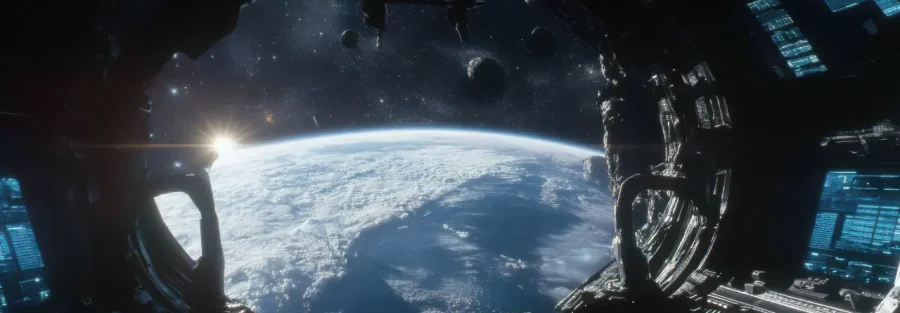Space is no longer science fiction—it’s an operational theatre for innovation, economics, and geopolitics. From Mars bases to LEO (Low Earth Orbit) satellite constellations, the infrastructure once seen only in movies is now redefining industries here on Earth.
In Brief:
- China’s robotic Mars base by 2038 featuring ISRU tech (water, oxygen, fuel).
- NASA–SpaceX alliance has slashed Earth to orbit costs by 4–10× versus NASA’s historic models.
- Space-as-a-Service economy is expected to reach $9.3 B in small-satellite operations by 2030, rising to tens of billions globally.
- LEO satellites are revolutionizing broadband, climate monitoring, navigation, defense, and data analytics.
- The global space economy is projected to hit $1.5–1.8 trillion by 2035.
- China’s Ambitious Mars Base by 2038
China’s CNSA plans a robotic research station on Mars by 2038, demonstrating In-Situ Resource Utilization (ISRU) to produce water, oxygen, and fuel—critical groundwork for future human missions.
- The Tianwen-3 robotic sample-return mission is scheduled for launch in late 2028 and is expected to deliver 500 g of Martian soil by 2031.
- Crewed missions may begin as early as 2033, with long-term plans for a sustainable, nuclear-powered fleet of Mars vehicles.
Why it matters:
This isn’t just exploration—it’s a testbed for Earth-critical resource tech, autonomous systems, and robotics that can spin off into mining, environmental monitoring, and advanced manufacturing.
- NASA–SpaceX: Revolutionizing Cost & Collaboration
Public-private teamwork is cutting space costs in unprecedented ways:
- SpaceX changed the game when it developed the Falcon 9 rocket for just $390 million—a tiny fraction compared to NASA’s projected cost of $1.7 to $4 billion.
- Each Falcon 9 launch now costs SpaceX around $15 to $28 million, while older programs like the Space Shuttle cost over $400 million per launch, and NASA’s new SLS rocket costs up to $1.7 billion per flight.
- Since the successful Demo-2 mission in 2020, SpaceX’s Crew Dragon has revived human spaceflight from U.S. soil and laid the foundation for a new era of commercial space missions and upcoming lunar exploration.
Why it matters:
This shift from cost-plus to fixed-price, reusable rockets slashes budgets, reduces time delays, and unlocks consistent access to orbit, paving the way for routine space services and innovation.
- Space-as-a-Service: The Next SaaS?
What was once the domain of superpowers is now an open marketplace. The Space-as-a-Service (SaaS) model allows governments, corporations, and startups to lease orbital real estate and access satellite data on-demand.
- With $9.3B projected in small-satellite operations alone by 2030, this vertical will become a cornerstone of Earth’s digital infrastructure.
- Companies in logistics, agriculture, insurance, and national defense can plug into real-time data without owning a single satellite. Those who understand how to translate this data into insights will gain significant competitive advantages.
Why it matters:
This model empowers startups and governments to “rent” space infrastructure rather than build it—fostering agile innovation in agriculture, disaster relief, navigation, and military surveillance.
- LEO Tech: A New Utility Layer
Low Earth Orbit has emerged as a critical infrastructure tier—joining roads, water, electricity, and cloud computing.
- Connectivity: Starlink and other constellations are bridging digital divides.
- Surveillance & Defense: Nations now track troop movements and environmental changes from orbit.
- Climate Analytics: Satellites provide granular insight into forest fires, ocean temperatures, and CO₂ levels.
Why it matters:
Countries that treat LEO as essential infrastructure—investing in cybersecurity, satellite redundancy, and domestic capability—will be better positioned to compete economically and geopolitically.
- Future Space Strategies & Technologies
Key innovations fueling the space transformation:
- Reusability: SpaceX’s rapid fail fast culture resulted in 140 launches in 2024, with each booster reused multiple times—cutting marginal costs to 10% of new hardware.
- Automation & in orbit servicing: Robotics in orbit can refuel satellites, remove debris, and maintain long-duration missions.
- Robotic precursors: China’s use of autonomous base-builders and nuclear propulsion paves the way for human missions with minimal risk.
Why it matters:
These aren’t isolated breakthroughs—they’re infrastructure-level innovations that will underpin how we build, communicate, and defend in the next 50 years.
Final Take: Why Earth Needs Space
The space frontier is no longer exotic—it’s infrastructure, economy, and strategy. From robotic bases on Mars to broadband from orbit, space is rapidly becoming embedded in daily life and global systems. These advances are driving:
- Innovation: In AI, robotics, materials, and energy.
- Economy: With a projected $1.5–1.8 trillion space-centric global economic booms by 2035.
- Security & Sustainability: Enhanced monitoring, climate data, and defense capabilities.
- Access: Democratization of space services through subscription models and commercial infrastructure.
These endeavors prove that space explorations aren’t separate from us—it is integral, essential, and transformative across society. Mars missions, lunar bases, and satellite services today are investments in Earth’s future.
References
- Morgan Stanley (2023) – Space Economy expected to reach $1.5–$1.8 trillion by 2035
https://www.morganstanley.com/ideas/investing-in-space - Allied Market Research (2022) – Small Satellite Market projected to hit $9.3B by 2030
https://www.alliedmarketresearch.com/small-satellite-market - NASA OIG Report (2011) – Falcon 9 cost: $390M vs. NASA’s $1.7–$4B estimate
https://oig.nasa.gov/audits/reports/FY11/IG-11-022.pdf - GAO Report (2023) – SLS launch cost up to $2.2B per flight
https://www.gao.gov/assets/gao-23-105869.pdf - NASA (2020) – Crew Dragon Demo-2 restored U.S. human spaceflight
https://www.nasa.gov/mission_pages/station/research/news/spacex-demo-2/ - Space News (2022) – China’s Tianwen-3 and Mars base plans
https://spacenews.com/china-details-plan-to-bring-martian-soil-to-earth/





